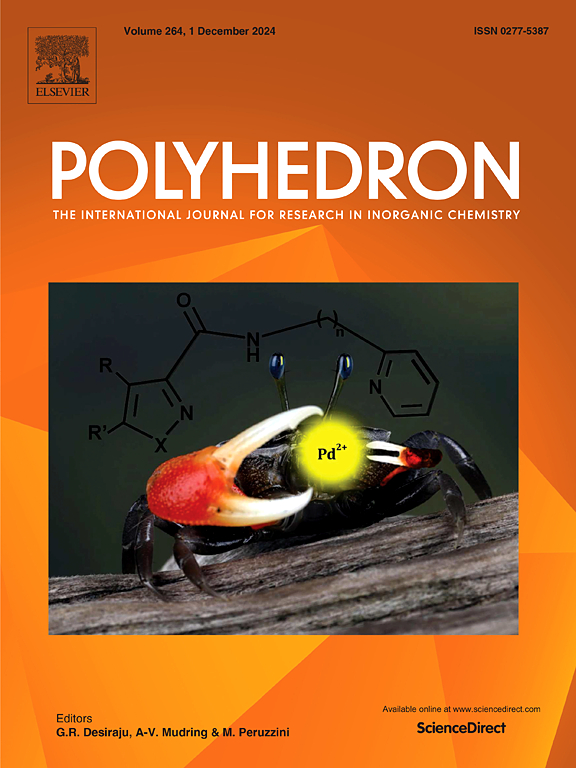一种含有拟六方柱状Cu6S6和线性cd3 -氧簇的新型杂金属配位化合物:多组分自组装,对水中硝基芳香族化合物的发光响应
IF 2.4
3区 化学
Q2 CHEMISTRY, INORGANIC & NUCLEAR
引用次数: 0
摘要
逐步结晶策略是构建Cu6S6簇基异金属配位化合物最常用的方法。本文采用一锅法,通过软、硬酸碱识别,多种组分有序自组装,得到了一种含有拟六方柱状Cu6S6和线性cd3 -氧簇的新型杂金属配位化合物{[Cu6(mna)6Cd3(ip)(en)4(H2O)2]·(溶剂)x}n (1) (H2mna = 2-巯基异烟酸,H2ip =异苯二甲酸,en =乙二胺)]。为构建cu6s6基异金属配位化合物提供了一种新的策略。化合物1是由[Cu6(mna)6]6 -金属配体、线性cd3 -氧簇、单Cd2+离子和(ip)2 -阴离子构成的含有直径为9.53 Å的微孔通道的罕见三维框架。化合物1在固态状态下发出红光,最大发射波长为650 nm。在水中的荧光传感实验表明,化合物1对硝基苯(NB)、4-硝基甲苯(4-NT)、4-硝基苯酚(4-NP)和1,3-二硝基硝基苯(1,3- dnb)等硝基芳香族化合物(NACs)具有敏感的发光猝灭反应,其猝灭常数KSV的减小顺序为:4-NP >;1、3-DNB比;NB祝辞4-NT。化合物1和4种NACs中荧光基团的HOMO和LUMO计算表明,光致电子转移在荧光猝灭中起重要作用,而4-NP与荧光基团之间的竞争吸收和氢键的协同作用导致4-NP对化合物1的猝灭效率最高。本文章由计算机程序翻译,如有差异,请以英文原文为准。

A new heterometallic coordination compound containing pseudo-hexagonal columnar Cu6S6 and linear Cd3-oxo clusters: Multicomponent self-assembly, luminescent responses to nitroaromatic compounds in water
The stepwise crystallization strategy is the most commonly used method to construct Cu6S6 cluster-based heterometallic coordination compounds. In this work, a new heterometallic coordination compound containing pseudo-hexagonal columnar Cu6S6 and linear Cd3-oxo clusters, {[Cu6(mna)6Cd3(ip)(en)4(H2O)2]·(solvents)x}n (1) (H2mna = 2-mercaptoisonicotinic acid, H2ip = isophthalic acid, en = ethylenediamine)], was obtained by a one-pot strategy, in which multiple components are self-assembled in an ordered manner through soft and hard acid-base recognitions, providing a new strategy for constructing Cu6S6-based heterometallic coordination compounds. Compound 1 is a rare three-dimensional framework containing microporous channels with a diameter of 9.53 Å, constructed from [Cu6(mna)6]6− metalloligands, linear Cd3-oxo clusters, single Cd2+ ions and (ip)2− anions. Compound 1 in the solid state shows red light emission with a maximum emission wavelength of 650 nm. The fluorescence sensing experiments in water indicate that compound 1 presents sensitive luminescence quenching responses to nitroaromatic compounds (NACs) such as nitrobenzene (NB), 4-nitrotoluene (4-NT), 4-nitrophenol (4-NP), and 1,3-dinitronitrobenzene (1,3-DNB), and the corresponding quenching constants (KSV) decrease in the following order: 4-NP > 1,3-DNB > NB > 4-NT. The calculation of HOMO and LUMO of fluorescence moiety in compound 1 and four NACs show photoinduced electron transfer plays an important role in fluorescence quenching, while the synergistic interactions of competitive absorption and hydrogen bonds between 4-NP and fluorescence moieties lead to the highest quenching efficiency of 4-NP to compound 1.
求助全文
通过发布文献求助,成功后即可免费获取论文全文。
去求助
来源期刊

Polyhedron
化学-晶体学
CiteScore
4.90
自引率
7.70%
发文量
515
审稿时长
2 months
期刊介绍:
Polyhedron publishes original, fundamental, experimental and theoretical work of the highest quality in all the major areas of inorganic chemistry. This includes synthetic chemistry, coordination chemistry, organometallic chemistry, bioinorganic chemistry, and solid-state and materials chemistry.
Papers should be significant pieces of work, and all new compounds must be appropriately characterized. The inclusion of single-crystal X-ray structural data is strongly encouraged, but papers reporting only the X-ray structure determination of a single compound will usually not be considered. Papers on solid-state or materials chemistry will be expected to have a significant molecular chemistry component (such as the synthesis and characterization of the molecular precursors and/or a systematic study of the use of different precursors or reaction conditions) or demonstrate a cutting-edge application (for example inorganic materials for energy applications). Papers dealing only with stability constants are not considered.
 求助内容:
求助内容: 应助结果提醒方式:
应助结果提醒方式:


